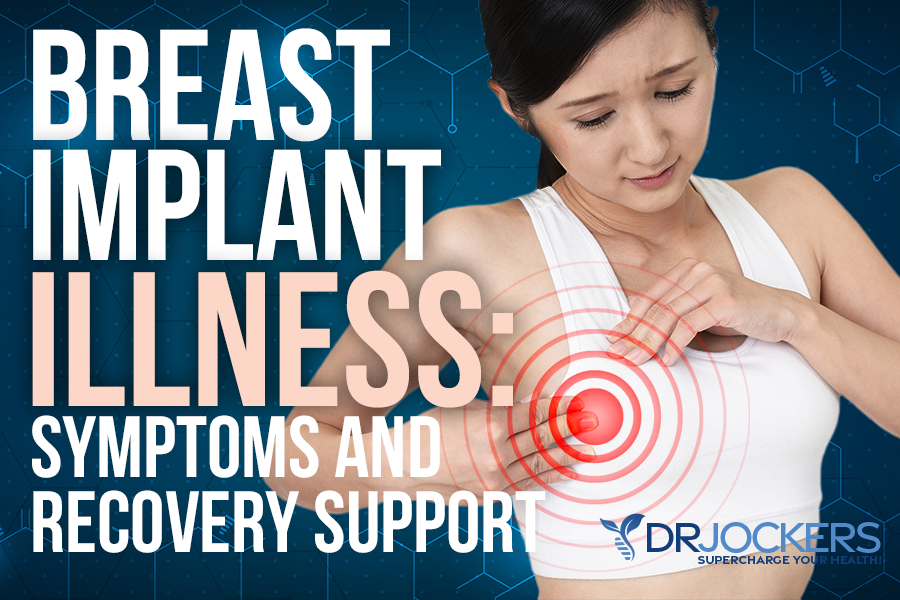 Breast Implant Illness: Symptoms and Recovery Support
Breast Implant Illness: Symptoms and Recovery Support
My wife, Angel and I sat down recently for a podcast episode. She got really vulnerable talking about getting breast implants when she was younger, developing breast implant illness recently, and getting her implants removed to improve her health.
Breast implants are incredibly common. So is breast implant illness. Breast implant illness is a group of symptoms that you may experience if you have breast implants. Removing implants is the first step, then you have to support your body through recovery, detoxification, and healing.
In this article, you learn what breast implant illness is. I will go over the potential symptoms of breast implant illness. You will understand why breast implants are so toxic. I will go over the steps for diagnosing breast implant illness.
You will learn about the process of breast implant removal and optional procedures involved with explants. Finally, I will recommend my top natural support strategies to use after surgery. I also recommend that you listen to this podcast episode here to learn more about Angel’s personal journey.
What is Breast Implant Illness
Breast implant illness (BBI) refers to a group of symptoms that you may experience if you have breast implants. Though it is not yet considered to be an official medical diagnosis, more and more people are aware of this phenomenon and terminology referring to breast implant-related symptoms and health complications (1).
Symptoms of breast implant illness may develop soon after implant insertion. In most cases, however, symptoms develop later, often 5 or 10, or even 20 years down the line. Symptoms of breast implant illness may affect anyone regardless of the length of time passed since surgery and the type of implant used.
There is a risk with every type of implant, including saline, silicone, smooth implants, textured implants, and so on, according to the U.S. Food and Drug Administration (FDA) medical device reports (MDRs) (2). And you are at risk even if your implants are new and even if you’ve had them for a long time without issues.
Symptoms of breast implant illness may include fatigue, joint pain, brain fog, and other chronic issues. My wife, Angel, noticed that she was getting sick more frequently than before and having more trouble recovering than before she started experiencing symptoms of breast implant illness.
She also had trouble losing weight after our fourth baby despite eating a clean, healthy diet and intermittent fasting. Spoiler alert: her weight dropped quickly once the implants were removed.
Since breast implant illness is not an official medical term, you may hear people, including doctors, referring to breast implant illness with other terms. In some cases, doctors are aware that your symptoms may be related to breast implants but used the term breast implant disease or silicone implant illness, for example, instead of breast implant illness.
In other cases, they may not be aware of the risks and symptoms of breast implant illness and write ‘unexplained systematic symptoms’ or something more general on your chart. Other terminology you may see for breast implant illness may include (3):
- BII (an acronym for breast implant illness)
- Breast implant disease
- Silicone implant illness
- Unexplained systematic symptoms
- Generalized unexplained illness
- Autoimmune or autoinflammatory syndrome induced by adjuvants (ASIA)
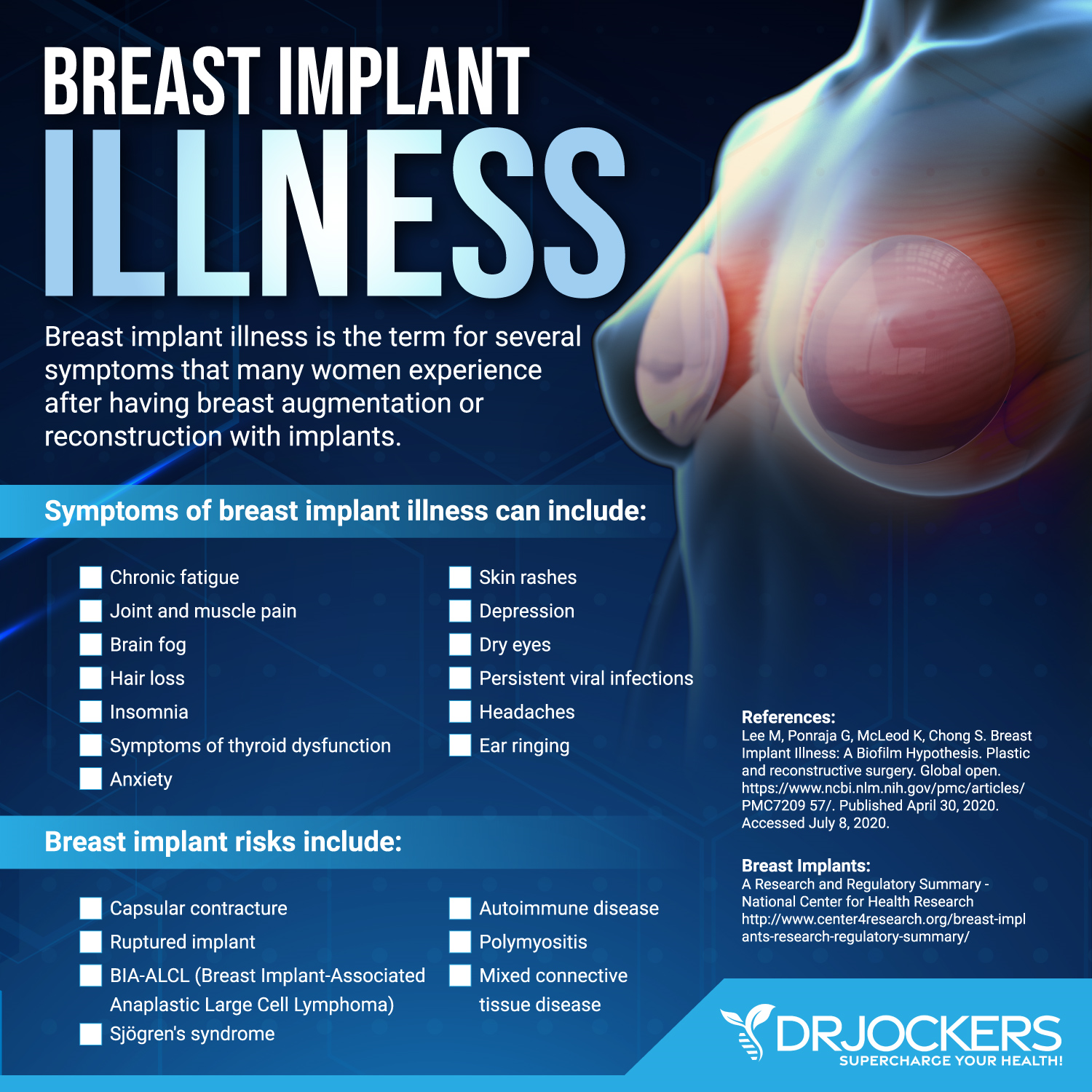
How Common Is Breast Implant Illness?
As you may know, breast implants are incredibly common. According to a 2010 research published by the Canadian Journal of Plastic Surgery, about 1 percent of the female population in North America had breast augmentation (4). These numbers have only increased since then. According to a 2021 review published in Plastic and Reconstructive Surgery – Global Open, there has been a 48% increase in breast implant surgeries between 2000 and 2018 in the United States (5).
About 17.6 percent of all plastic procedures around the world are breast augmentations. About 17.3 percent of these are done in the US, 14.8 percent in Brazil, 3.8 percent in Mexico, 3.5 percent in Germany, 3.5 percent in Italy, 2.7 percent in Argentina, and 2.3 percent in Colombia.
Breast implants are the most common in those between 35 and 50 at 46.4 percent. About 37.2 percent of women between 18 and 34 have or had breast implants. 12.7 percent of women between 51 and 64, 2.5 percent of 65 and older, and 1.2 percent of those 17 and under had breast implants in the US, according to 2019 data (6).
Breast implants are very common even in the holistic and natural health world, even among practitioners. Women may get them for a variety of reasons, including low self-esteem, lack of confidence, or societal pressure to look a certain way. Of course, a lot of women also get breast implants after a mastectomy due to breast cancer or breast cancer prevention with a breast cancer gene.
Even though breast implant procedures are very common, many women are not aware of the risks of breast implant illness or they were not aware at the time of the surgery. Due to underreporting, missing information, duplicates, and other gaps, it is difficult to know exactly how many people are struggling with breast implant illness. Many individuals or even their doctors, don’t even know that this is their issue.
According to the FDA, the most common onset of symptoms is 42 years old. However, symptoms may arise between 9 and 88. Yes, this means that children who were born to mothers with breast implants may also be affected. The onset of symptoms may develop between 0 and 42.5 years after insertion, according to the data.
This probably means that none of the participants studied had implants longer than 42.5 years, and symptoms may arise even later. The average time from implant insertion until the development of symptoms is about 5.1 years (1).
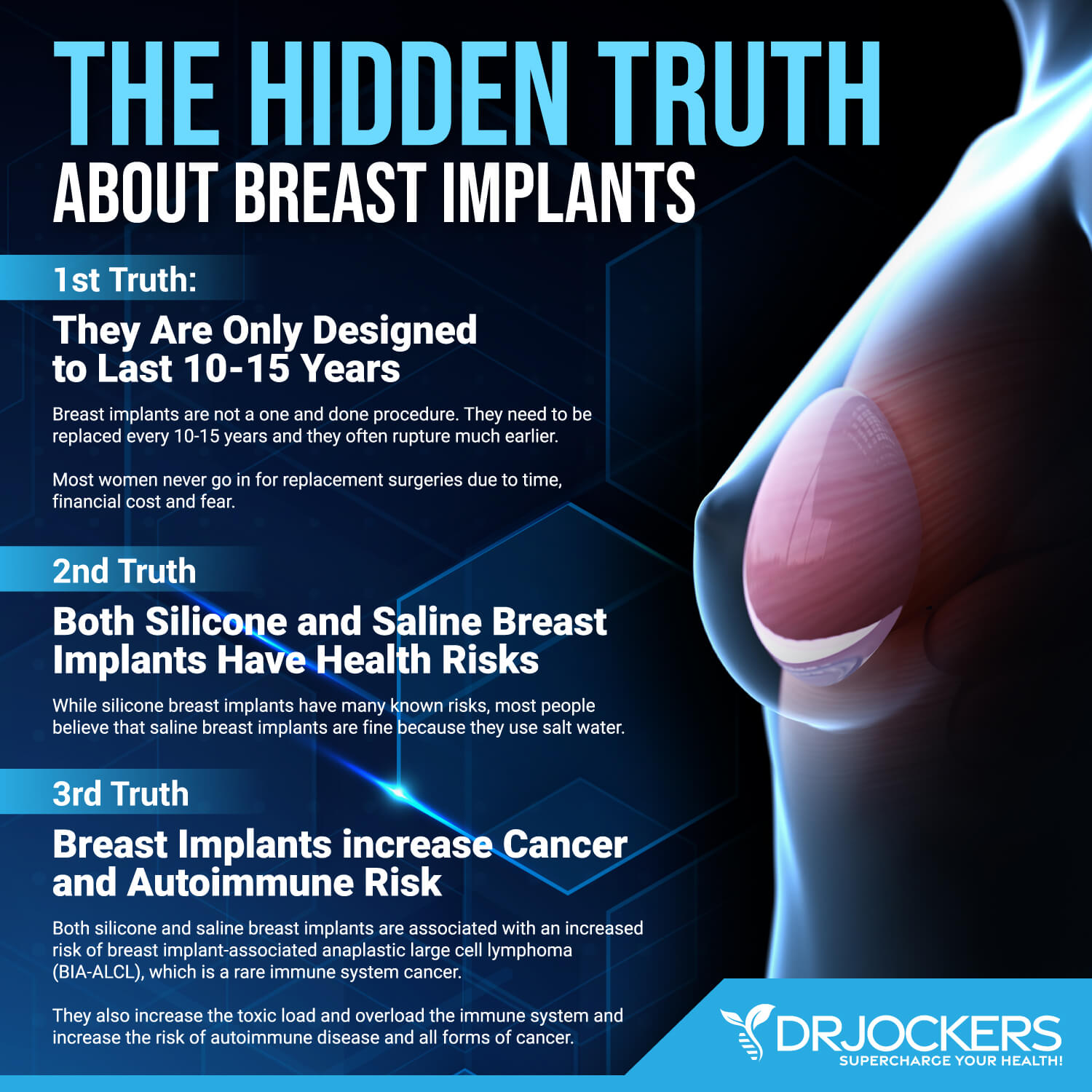
Potential Symptoms of Breast Implant Illness
Symptoms of breast implant illness may depend from person to person. Some symptoms are incredibly common, while other symptoms are more rare.
Common symptoms of breast implant illness may include:
- Breast pain
- Extreme tiredness and fatigue
- Sleep issues
- Brain fog
- Concentration issues
- Memory issues
- Muscle aches and pain
- Joint pain
- Swelling of the joints
- Chronic symptoms resembling autoimmune illness
- Diagnosis of an autoimmune disease
- Vision problems or eye issues
- Skin rashes
- Weight gain or trouble losing weight
- Getting sick often or poor immune health
Other potential symptoms of breast implant illness may include:
- Headaches or migraines
- Digestive issues
- Dry skin
- Dry hair
- Hair loss
- Dry eyes
- Anxiety
- Panic attacks
- Depression
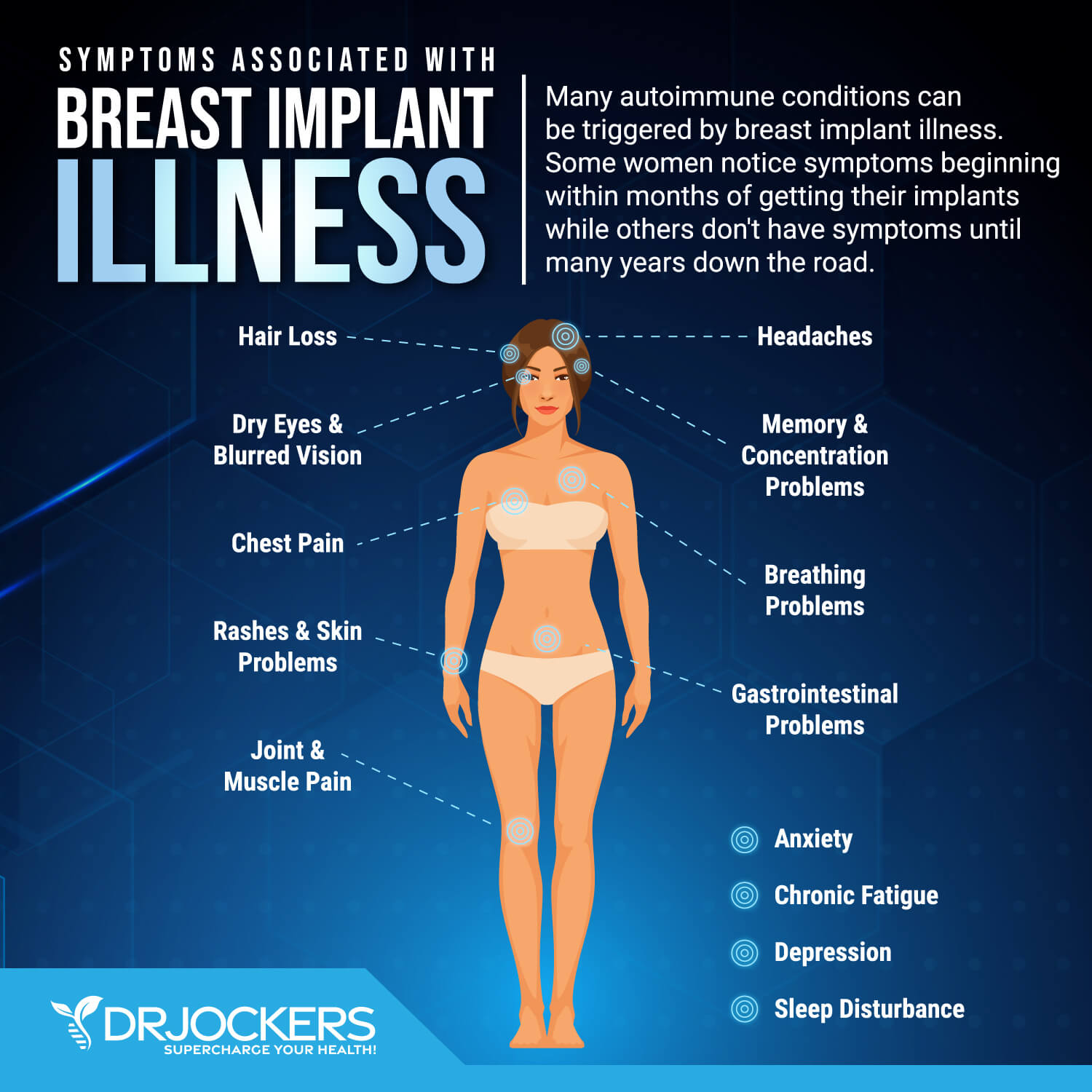
Why are Breast Implants Toxic?
You may develop breast implant illness for a variety of reasons, including:
- The breast implant itself
- Certain pieces of the breast implant
- Leaking silicone in silicone breast implants
- Chemical exposure to breast implants
- Mold formation on and within the implants
- Bacteria contamination, biofilm contamination, and other contaminants due to the breast implants
But why are breast implants so toxic? Are they all toxic? Yes, both silicone and saline breast implants can be toxic and cause issues, as well as, all shapes, sizes, and textures.
There are two main types of breast implants out there: silicone breast implants and saline breast implants. Both types can be used for a variety of reasons, including improving shape, offering size and fullness, and reconstructing breasts following a mastectomy.
Silicone breast implants are obviously filled with silicone, more specifically, silicone gel. Silicone gel is a thick fluid. It is used for breast implants because it feels very similar to human fat and can make the breasts feel and look more similar to natural breasts.
Saline implants are done in a similar way. They still use silicone pockets. However, they are filled with saline, which is a saltwater solution. Many believe that saline implants offer an even more natural feel and look compared to silicone implants.
Some breast implants are smooth, some are textured. Smooth breast implants move around freely, resembling natural breast tissue. Textured implants are more rough, similar to sandpaper. This means that they stick to your breast tissue, stay in place, and don’t move around like smooth implants.
How are breast implants inserted? They are inserted under your existing breast tissue. Your surgeon will make an incision under the breasts or armpit area to put the implants under or on the top of your chest muscles. Here is a helpful image below from the Cleveland Clinic on breast augmentation surgery.

Different Types of Breast Implants
No matter what option you choose, there are risks. Though many claim that silicone breast implants only pose a risk if they end up rupturing and leaking, this may not be the case. There is a health risk even if the breast implant is not ruptured (7).
You may not know this, but silicone breast implants can start leaking at any time — even without you knowing it. We are talking about a substance that’s gel-like. This means that you won’t notice any changes in the implant right away, even if there is a tiny break or leak. The implant may still look or feel the same. You may not have symptoms right away or may not realize that your symptoms are due to your breast implant.
There is a reason that many doctors recommend getting an MRI yearly to check for breast implant ruptures and leakage. Of course, getting frequent MRIs holds some risks (it’s radiation!). And once a year may not be enough. Many months may pass before it’s noticed. And leaking silicone can migrate to other areas of your body where it cannot be removed from.
Though doctors recommend changing your breast implants every 10 to 15 years, many ruptures develop within 3 to 10 years after surgery, before the recommended removal. Many women don’t change their implants either due to financial issues, fear of surgery, or other reasons.
Leakage is not the only issue, though. Silicone actually contains toxins and carcinogens that can increase the risk of chronic inflammation, connective tissue diseases, and all kinds of chronic symptoms we talked about earlier (8, 9). And as a carcinogen, it may increase your risk of cancer too.
It’s not just silicone implants, though. According to the FDA, silicone and saline breast implants may increase the risk of breast implant-associated anaplastic large cell lymphoma (BIA-ALCL), which is a rare immune system cancer (7). It seems that textured implants pause the highest risk of cancer. However, all kinds of implants may increase your risk.
You may be surprised to hear that even saline breast implants have a significant health risk. It’s not only salt water. First of all, remember, saline breast implants are also made with silicone pockets.
According to the FDA, textured implants with saline solution still pose similar risks as textured breast implants with silicone (7). Smooth saline implants have lower risks, but there are still many cases of women developing BIA-ALCL with smooth saline breast implants.
What if saline implants leak? It’s just salt water, it can’t be an issue, right? Wrong! Saline implants are very prone to bacteria, mold, and yeast growth (10). Any tear, damage, or deterioration can allow bacteria to other pathogens to take residence and grow inside your breast implant.
This is already an issue, but if there is leakage, these pathogens can spread through your body, causing chronic infections and other health issues. Saline implants may also lead to the deterioration of chest muscles and related respiratory issues (11).

Diagnosing Breast Implant Illness
Right now, there isn’t one specific test used for the diagnosis of breast implant illness. Diagnosis will include going over your medical history and symptoms. A variety of blood and other tests may be ordered to rule out other diseases, including Lyme disease, arthritis, autoimmune issues, and so on.
Your symptoms going away after the removal of breast implants may be the best proof of breast implant illness. However, removing the implants may not make your symptoms go away — at least not right away and not automatically, but you will need further detoxification and treatment to feel like your former healthy self. I will offer some support strategies to enhance your recovery and health after breast implant removal surgery in the last section of this article.

The Process of Breast Implant Removal
Treating breast implant illness starts with the removal of the breast implant and removing the scar tissue around the breast implant, called capsulectomy. It’s important that you work with a reputable, board-certified plastic surgeon experienced in explantation and addressing breast implant illness if you are considering breast implant removal (2, 4).
There are several types of breast implant removal options:
- En bloc explantation: This procedure means that your doctor removes both the breast implant and the scar tissue as one unit. This procedure reduces the risk of chemicals and other substances escaping into your body during the surgery, as well as fluid buildup (seroma). This is the best way to get the procedure done.
- Explant with total capsulectomy: In this case, your surgeon will remove the implant first, then the capsule and scar tissue.
- Explant with partial capsulectomy: This procedure removes the implant but only a portion of the scar tissue.
- Open capsulotomy: This procedure removes the capsule but not the scar tissue.
This is what you may expect post-breast implant removal surgery:
After breast implant illness, it is not recommended to get new breast implants, even from different materials or different textures, shapes, or sizes. There are some alternative reconstruction options to use to improve the shape or size of the breast. It’s important to go over these options before your breast implant removal surgery. I will go over these options in the next section.
After the removal of the implant, your doctor will likely rinse the treated area with an antibiotic solution. This is important to address and abolish any bacteria present and reduce the risk of any bacterial infections. They may also send a tissue sample for lab analysis to rule out any issues, including BIA-ALCL or bacterial infections.
Bacterial contaminations or biofilm growth are quite common. According to a 2022 review published in Eplasty, they found at least one bacterial contaminant in about 68.5 percent of patients with breast implant illness after explantation surgery (2).
The most common bacteria was Propionibacterium acnes in 49.6 percent of cases. Other common bacterias found include Staphylococcus epidermidis (26.2 percent), Propionibacterium granulosum (16.8 percent), and Alpha-hemolytic Streptococcus species (8.7 percent).
Various fungi may also be found, including Candida albicans (1.5 percent) and Aspergillus fumigatus(1.5 percent). To treat potential bacterial and fungal infections, you may be prescribed anti-inflammatory medications, antibiotics, and/or antifungals post-surgery.
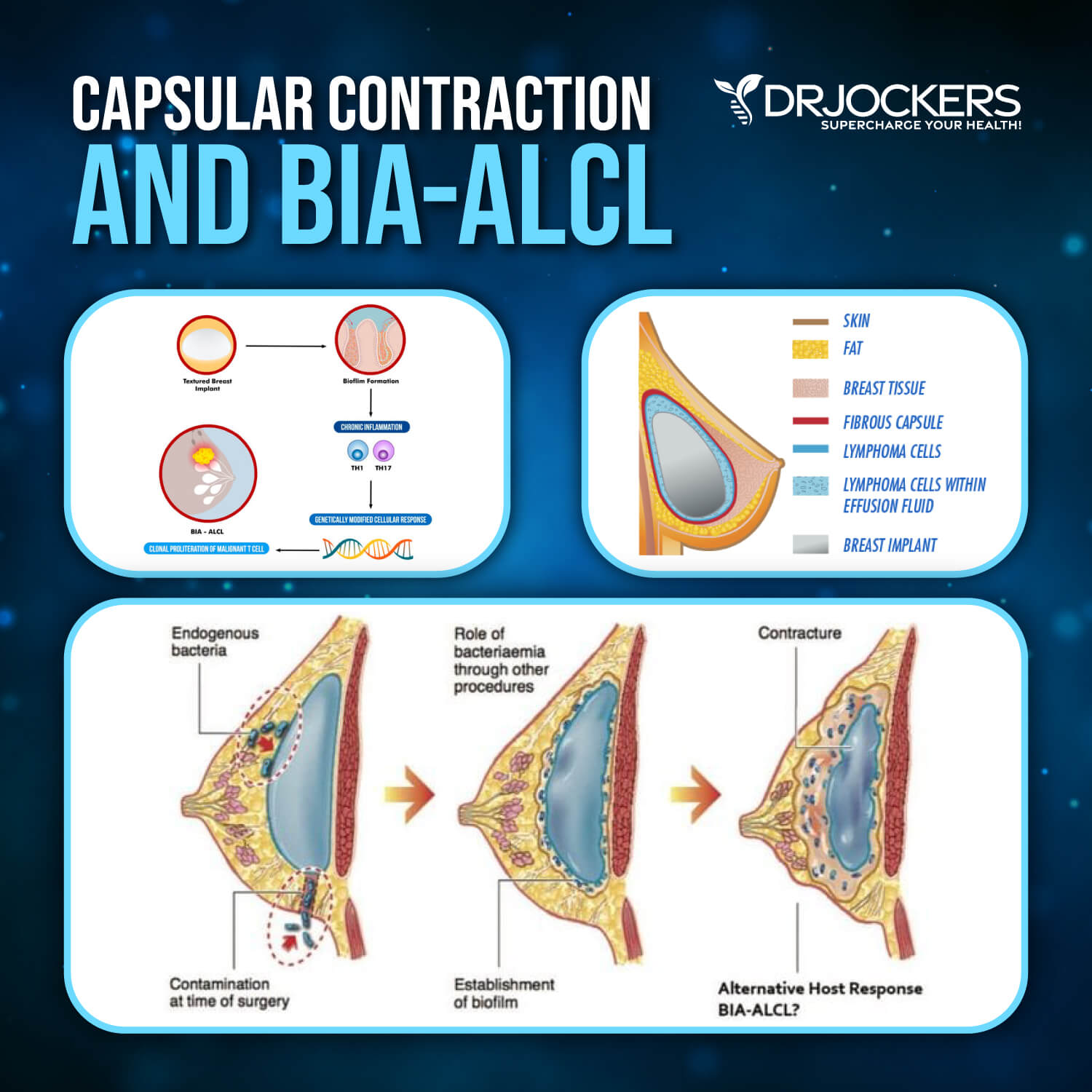
Optional Procedures Involved with Explants
As said, it is not recommended to get breast implants after breast implant removal. This is particularly important if you had breast implant illness. Even if you haven’t experienced symptoms of breast implant illness, you probably want to consider going without breast implants to reduce the risk of breast implant illness.
There are a variety of other procedures that can help to improve the shape and size of the breast and reconstruct the breast if you get a breast implant removal.
Breast Lift
Many women worry about sagging, flattening, and other issues related to looks and feel after breast implant removal. Since sagging skin is often inevitable after removing a larger breast implant, it’s normal to wonder about it. Your skin has to stretch to accommodate the shape and size of your breast implants.
Your skin may tighten naturally after explant surgery. However, if the skin is too stretched and not elastic enough, or if you had your implant for a long time, you had very large implants, or you are older, it won’t tighten naturally. But you don’t have to worry, there are options to return your breast into a natural and attractive state.
Getting breast lift surgery is one option to address this. Getting a breast lift helps to improve sagging tissue (ptosis) and nipple placement. It helps to create firm, perky, natural, and youthful-looking breasts without sagging skin.
This is a safe and effective procedure that can be done after the removal of your breast implants, usually done at the same time as your explantation surgery. Discuss these options with your surgeon during your breast implant removal consultation (12).
It is important to note, that while the results of the breast lift may be desirable, you always have to consider the risks involved in any type of surgery, the cost and the recovery process.
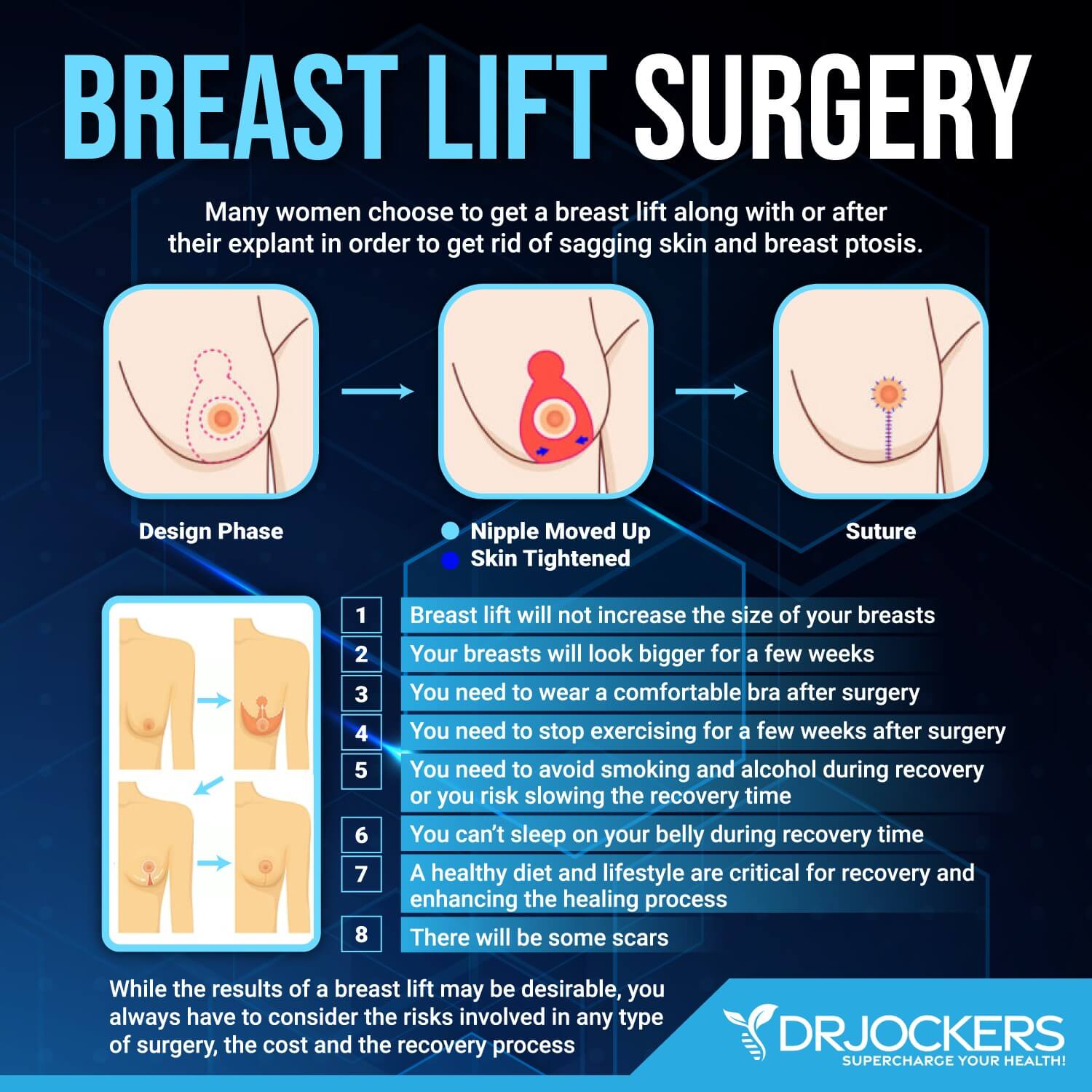
Fat Transfer
Another option for improving unwanted aesthetic effects of breast implant removal is a fat transfer or lipoaugmentation or lipofilling. This procedure basically takes fat from other areas of your body and adds it to the breast area. It refines breast contour with this fat. This option can replace the breast volume lost after explantation, improve size and shape, and create a natural look and feel.
Fat transfer is a convenient and effective option for compensating for the volume lost. Just like a breast lift, fat transfer can usually be done during the same surgery as breast implant removal. It’s called Simultaneous Implant Exchange with Fat (SIEF).
Your doctor can add fat grafts through your memory gland to reduce loss of volume and improve shape and size immediately. In some cases, you may need a second round of surgery to add more fat to the breasts. This procedure doesn’t involve any additional incisions or scarring. Using your own body tissue and improving breast aesthetics using fat create a natural look and feel (12, 13).
Most doctors don’t advise getting the fat transfer in the same surgical procedure as the explant because it is a long process that can be very challenging on the body. For a woman dealing with serious BII symptoms, it may make the recovery process overwhelming and set them back.
While the results of a fat transfer may be desirable, you always have to consider the risks involved in any type of surgery, the cost and the recovery process.

Adipose Tissue-Derived Stem Cells
Last but not least, adipose tissue-derived stem cells may be an option. While fat transfer is a great option after breast implant removal, it has its limits due to fat resorption issues. Injecting adipose-derived stem cells (ADSCs) instead of fat may help to improve and maintain the breast volume created from surgery. It may also lead to a further increase in breast volume.
Traditional fat transfer uses a stromal vascular fraction (SVF) as an injection. SVF doesn’t contain too many stem cells. However, it contains tissue extracellular matrix-degrading white blood cells called macrophages, which play a role in aging. Isolating ADSCs removes macrophages from the equation and lets stem cells expand.
This may help to achieve the desired and long-lasting results using minimal injections. Only 100-150 thousand cells/ml of fat may help to create a volume between 400 to 800 ml to achieve the size and shape desired.
Of course, both fat transfer and using ADSCs can help to remove fat from areas with undesired deposits, such as the thighs, hips, and belly area, achieving a double-aesthetic goal many patients love (14).
It is important to note, however, that while the results of the ADSC may be desirable, you always have to consider the risks involved in any type of surgery, the cost and the recovery process.
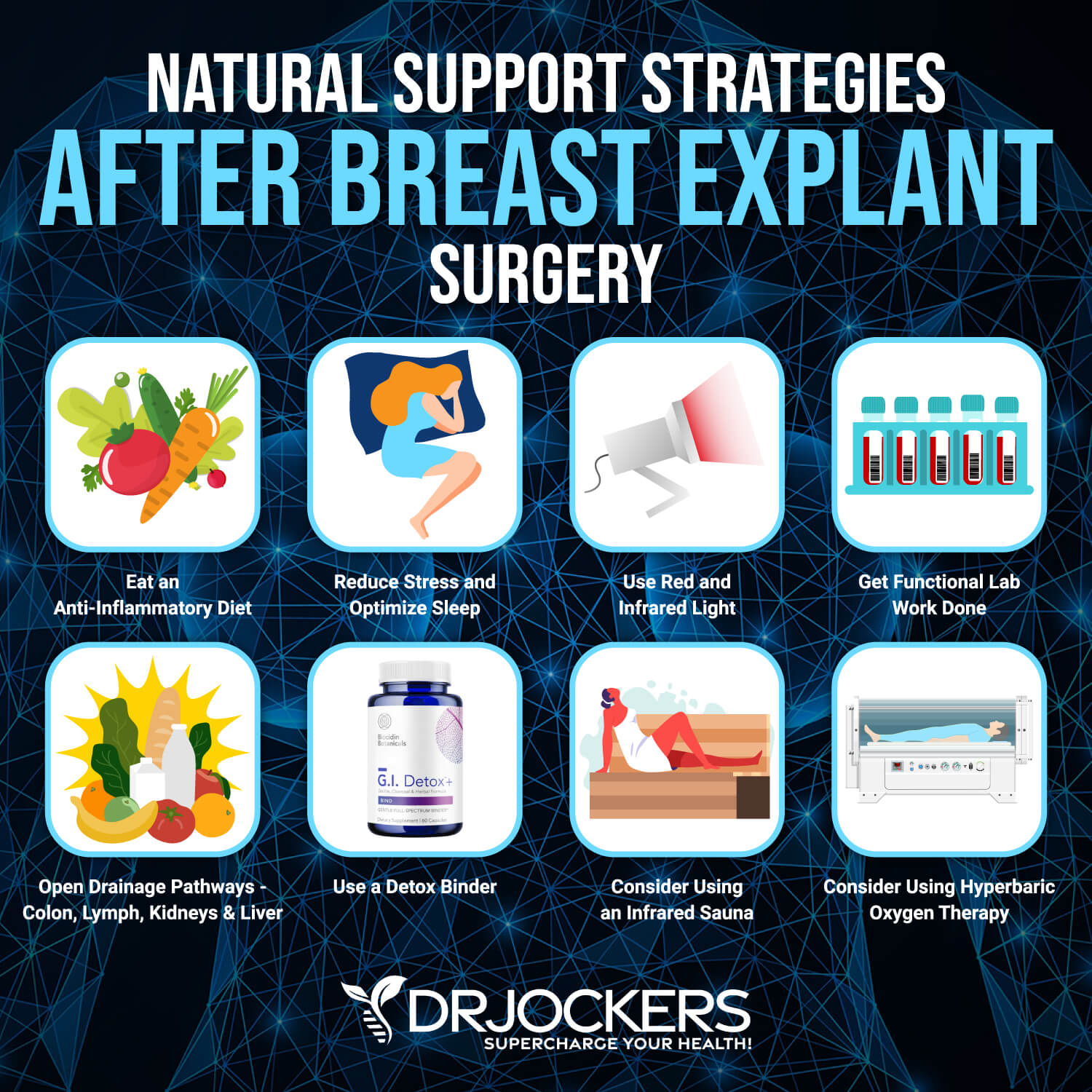
Natural Support Strategies After Surgery
While breast implant removal surgery is very important for your health to address symptoms or reduce the risk of breast implant illness, however, it is still a surgery that is hard on your body. Your body needs time to recover from surgery.
Not to mention that you may need to do some detoxification and other healing work to restore your body’s health and fully recover from breast implant illness.
My wife and I worked with our friend Diane Kazer who is an expert in breast implant illness and has a great program coaching women on everything they need to know about BII and how to strengthen the body before surgery and cleanse and heal properly afterwards. She has great resources here and a great book called Killer Breasts here
Follow a Healthy Lifestyle
Following a healthy lifestyle is incredibly important to support your recovery from surgery and improve your health from breast implant illness. Remove inflammatory foods, such as refined sugar and carbs, refined oil, gluten, and other food sensitivities, sodas and sugary drinks, deep-fried food, junk food, fast foods, and highly processed foods.
Follow a diet rich in greens, vegetables, herbs, spices, fermented food, low glycemic index fruits, grass-fed beef, pasture-raised poultry and eggs, wild game, and wild-caught fish and seafood.
Follow a low-carb, high-fat diet with lots of healthy fats, including olives, extra-virgin olive oil, coconut oil, avocados, pasture-raised butter and ghee, and other healthy animal fats. Try intermittent fasting.

Don’t forget to hydrate your body well. Start your day with 16 to 32 oz of water. Add some lemon juice or apple cider vinegar to kick-start your digestion. Drink a glass of water every hour or so. Add some lemon or lime juice, cucumber, basil, mint, other herbs, or berries for taste and extra nutrients.
Move your body throughout the day by incorporating regular stretching, short walks, yoga moves, or an impromptu dance session. Exercise at least 5 days a week for 20 to 30 minutes a day using a mix of strength and resistance training, cardiovascular movement, and light exercise. While you are still recovering from surgery, follow your doctor’s instructions, and keep it easy. Gradually get back to your routine as it’s safe.
You may benefit from specific exercises for your chest, shoulders, arms, and back to strengthen your chest area after breast implant removal. Such exercises may also help to improve the shape of your breast, as well as your posture, which can affect how you carry yourself and how your breasts look. You may work with a physical therapist to get started, especially as you get back into your routine after surgery or if you are new to exercise.
Sleep plenty and reduce stress. Try meditation, breath work, guided visualization, and gratitude. Incorporate prayer or spiritual practices that feel right for you. Go to sleep and wake up around the same time to support your circadian rhythms. Avoid stress, sugar, heavy foods, and electronics in the evening.
Choose reading, listening to music, journaling, coloring, arts and crafts, taking a bath, prayer, or other relaxing activities to help your wind down. Support your sleep with a supportive mattress, pillows, and bedding, blackout curtains, and an eye mask.

Red Light and Infrared Therapy
Red light therapy and infrared therapy may be incredibly helpful for the healing process for the skin and connective tissue in recovery from the explant surgery. They may help to reduce scarring and scar tissue development.
Red light therapy (RLT) uses red low-level wavelengths of light. It is on the “long end” of the visible spectrum and has wavelengths of 630 nm to 700 nm. Infrared light is invisible with an electromagnetic spectrum at 800nm to 1000 nm.
Infrared light therapy can be used at the surface of the skin, but it can also penetrate deeply about 1.5 inches into your body for deeper cellular support. Infrared therapy can also be used in combination with sauna therapy as part of an infrared sauna (more on that soon!).
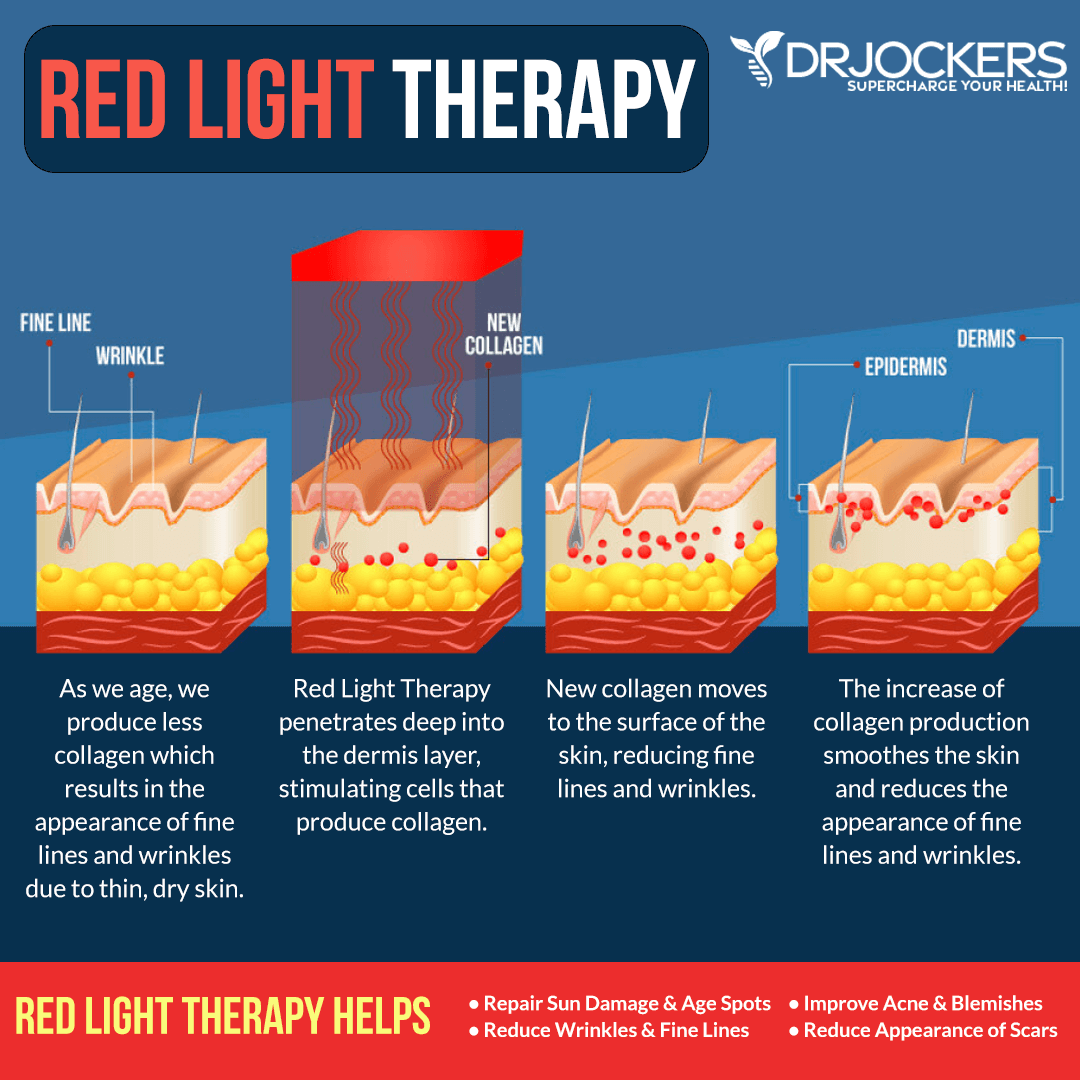
Red light therapy and infrared therapy are powerful therapeutic techniques used for skin rejuvenation, anti-aging, inflammation, pain, and other health concerns. It is an increasingly popular alternative healing tool that you can use in your own home. It is also commonly offered at alternative medical practices, holistic health centers, dermatology practices for cosmetic skin concerns, salons, and spas.
According to a 2013 study published in the Seminars in Cutaneous Medicine and Surgery and other research, low-level laser red light therapy may offer therapeutic benefits for the skin, including reducing pain and inflammation, tissue repair and healing, scarring, acne, burns, and wrinkles (15, 16, 17).
Infrared therapy may help to facilitate detoxification, reduce inflammation, and stimulate autophagy to support your healing process from breast implant illness (18, 19, 20). To learn more about red light therapy, I recommend this article.

Hyperbaric Oxygen Therapy
Hyperbaric oxygen therapy may be a great idea for the first month to accelerate healing. The hyperbaric chamber has pure oxygen coming in at pressures 1.5 – 3 times the normal atmospheric pressure.
It may help to reduce inflammation and swelling, support recovery by raising oxygen levels to be normal in areas of the surgery or injuries, encourage new blood vessel growth, and fight or reduce the risk of infections (21, 22). Sessions last 60 to 90 minutes each. You may learn more about hyperbaric oxygen therapy here.
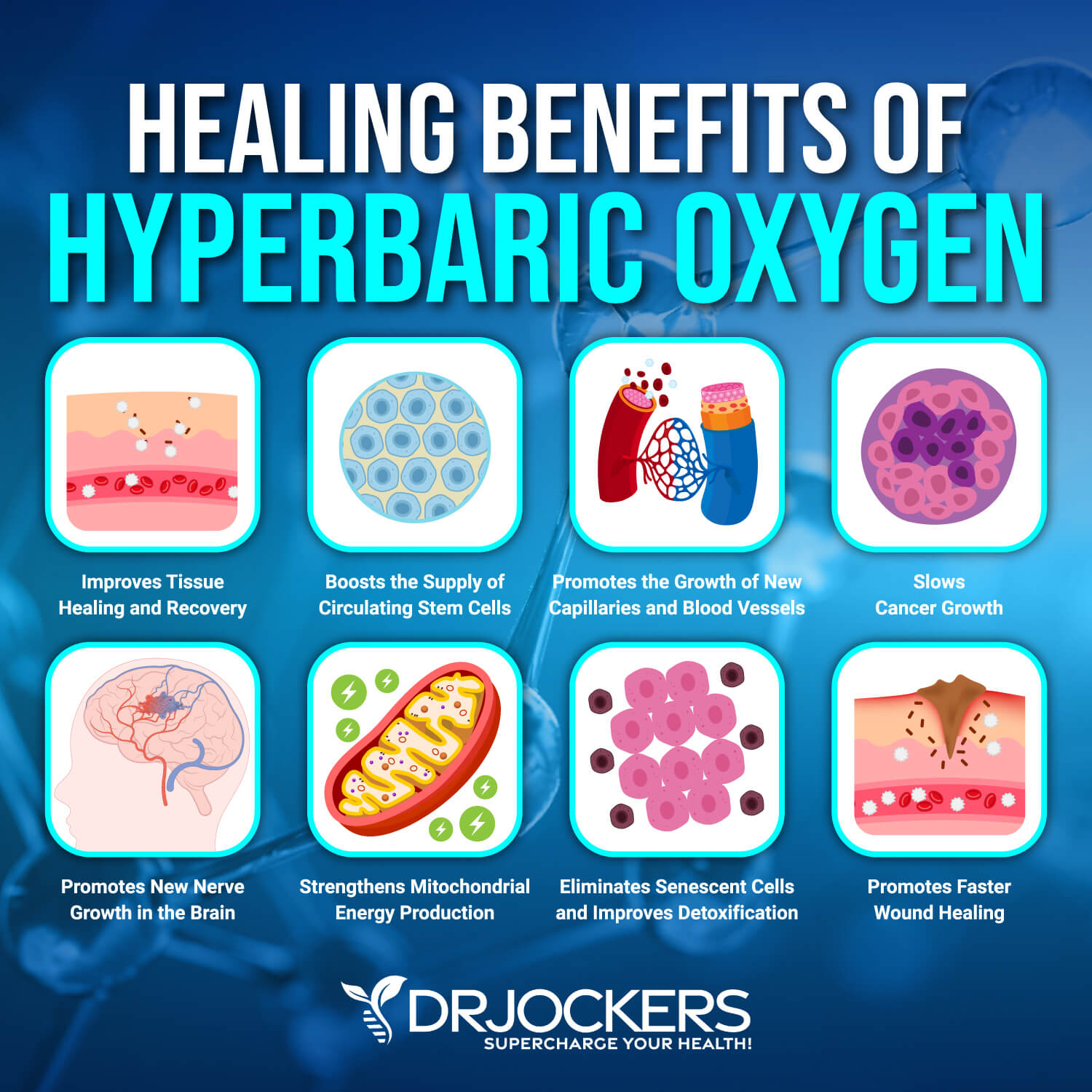
Get Functional Lab Work Done
I also recommend getting a variety of functional lab work done to check for underlying issues related to breast implant illness and support an appropriate diagnosis.
I recommend a Comprehensive Blood Analysis (CBA), which is a very detailed blood test that looks at all of these markers of inflammation and other health functions. This test is more sophisticated than most conventional doctors run. It looks at everything that a CBC and CMP do and more.
It examines all parameters for inflammation, blood sugar levels, insulin levels, immune system function, thyroid function, parathyroid hormone levels, mineral and electrolyte balance, zinc and copper ratio, vitamin A and D levels, folate, and vitamin B12 levels, a complete metabolic panel, complete blood count, liver function, kidney function, urinary tract health, nutrient deficiencies, and more. It is a great test to use for prevention, to determine treatment, and to track progress.
Organic Acid Test
I also recommend getting a Comprehensive Organic Acid Test to check for signs of dysbiosis, mitochondrial function, and fungal overgrowth. This is a simple urine test that looks at complex biomarkers from various metabolic pathways.
These biomarkers give an overview of several major systems in the body and an analysis of nutritional deficiencies in the body. Many functional medicine practitioners believe the organic acids test provides the most useful data for the dollar spent on any metabolic test.
The organic acid biomarkers are metabolic intermediates that are produced in pathways of central energy production, neurotransmitter breakdown, detoxification, and intestinal microbial activity. When specific organic acids are found accumulating, they often signal a metabolic insufficiency.
These insufficiencies could be related to toxicity, a nutritional deficiency, or an inherited enzyme deficit. Again, it’s great as a preventative tool to determine treatment and track progress.
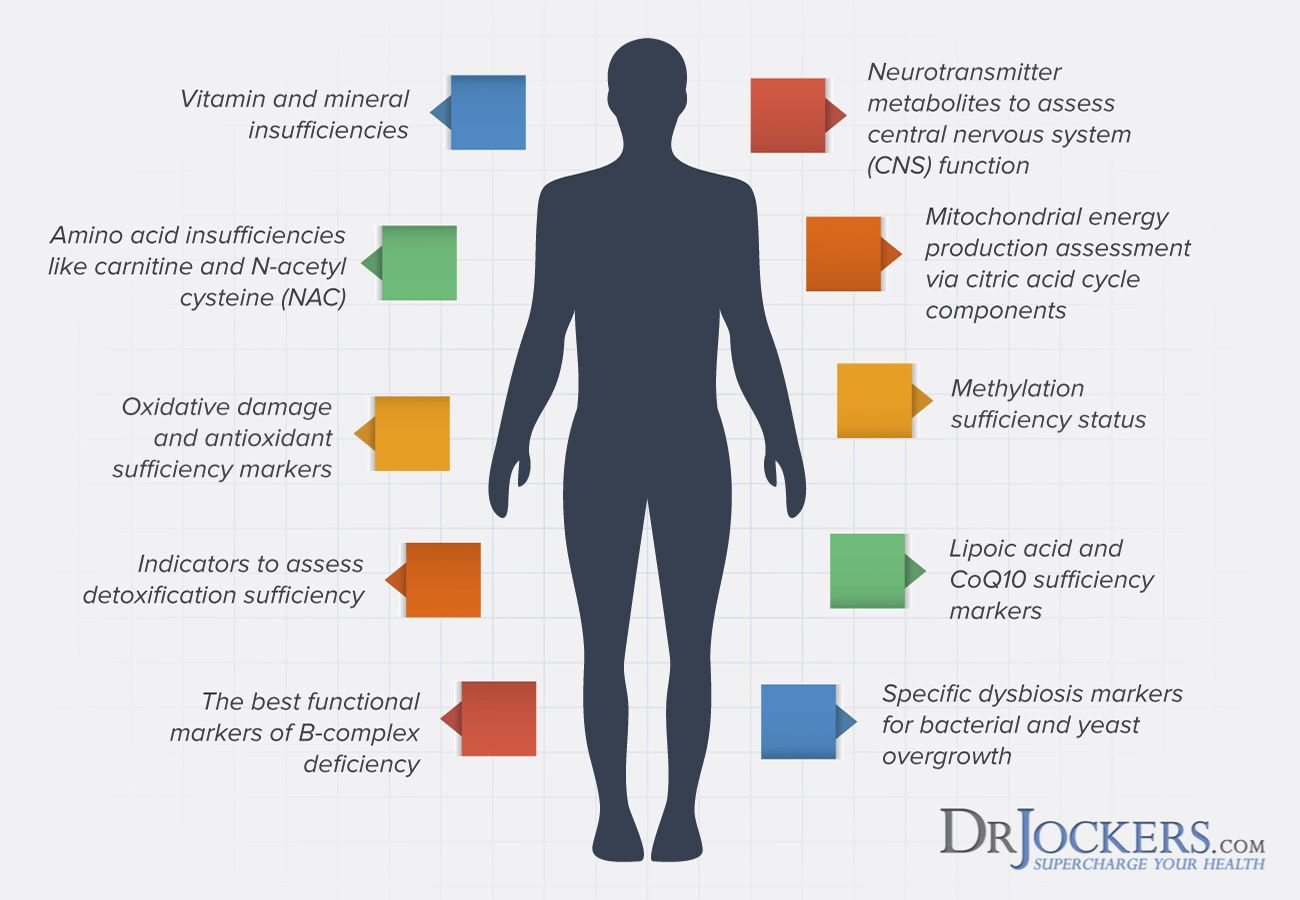 Open Drainage Pathways — Lymphatics, Liver, Kidneys
Open Drainage Pathways — Lymphatics, Liver, Kidneys
Breast implants can seriously increase toxin overload in your body, which may lead to chronic inflammation and chronic symptoms of breast implant illness. I recommend opening your drainage pathways to support detoxification and recovery.
As part of overall systemic drainage, it’s important to promote optimal drainage from the lymphatic into the kidneys and liver and then into the colon to ensure those elements removed through detox have a clear path out of the body. Support your lymphatic pathways by dry brushing your skin before showering and moving your body regularly. Rebounding is particularly great for lymphatic flow.
I also recommend supplementing with Lymph Active. This lymphatic detox formulation includes slippery elm bark, which functions as a mild diuretic, Astragalus root, which supports the liver and lymphatic system, Graviola, and Chuchuhuasi, which provides adrenal support. Additionally, we’ve added turkey rhubarb, sheep sorrel, and burdock root, whose anthraquinones, tannins, and plant sterols have antioxidant properties and other immune system-supporting properties.
Burdock root, specifically, has been shown to be particularly effective in supporting the body’s efforts to remove biofilm. This blend of natural ingredients and our BioActive Carbon allows for effective detoxification coupled with binding and die-off symptom mitigation.
This means your detox efforts are optimized while your progression toward overall wellness is maximized. Take 1 capsule twice daily. Lymph Active can be taken with or without food. For maximum potency, we recommend taking it between meals. You may learn more about lymphatic cleansing from this article.
Supporting the Kidneys and Liver
As an integral part of the body’s cleaning and filtering system, healthy kidney and liver function is essential to good health, especially when you are cleansing or healing from toxin overload. Support your liver and kidney health.
Eat lots of liver and kidney-friendly foods, such as grapefruits, cranberries, blueberries, prickly pear, beets, carrots, cruciferous vegetables, olive oil, and fatty fish. Try castor oil packs for liver detoxification. I also recommend using KL Support.
This product combines herbs and nutrients traditionally used to support kidney and liver health, including beetroot, collinsonia (stoneroot), gynostemma, marshmallow root, milk thistle seed, NAC, and parsley leaf. Together, these support fat metabolism, hepatic blood flow, and healthy urinary tract and bladder function while helping the body carry out its natural detoxification processes.
I recommend taking 2 capsules twice daily. You may learn more about cleansing your kidneys here. You may learn more about cleansing your liver from this article.
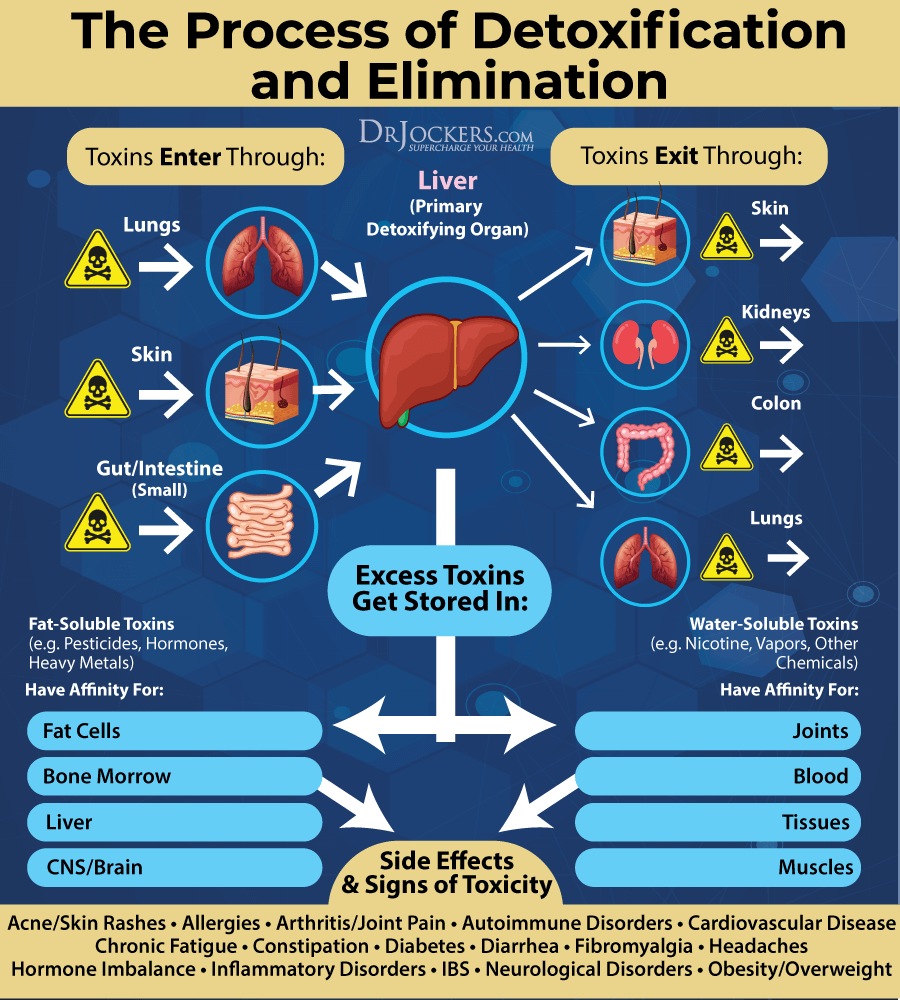
Infrared Sauna Usage
I also recommend using your infrared sauna regularly after the first month of recovery is over or as directed by your doctor. Infrared sauna is a type of sauna that releases infrared light. Infrared light is safe and goes deeper into your body, allowing it to release fat-soluble toxins, lower toxic burdens, and even enhance internal detox pathways as well.
It may help to facilitate detoxification, reduce inflammation, and stimulate autophagy to support your healing process from breast implant illness (18, 19, 20). To learn more about infrared sauna therapy, I recommend reading this article.

Use a Detox Binder
Binders are various substances that ‘bind’ to toxins by either trapping them or attracting them through a negative charge in your body, then helping them remove them through bowel movements. These are great tools for detoxification.
I recommend using GI Detox. This product is formulated to provide broader activity than a single-ingredient product. Zeolite clay, activated charcoal, and MMST silica, plus apple pectin, humic and fulvic acids, and aloe vera.
Binding and detoxification agents have long been used in traditional medicine and are supported by modern research. I recommend 1 capsule on an empty stomach with a full glass of water or as directed by a healthcare professional. Take 1 hour apart from other medications and supplements. You can learn more about binders from this article.
Final Thoughts
Breast implants are incredibly common. So is breast implant illness. Breast implant illness is a group of symptoms that you may experience if you have breast implants. Removing implants is the first step, then you have to support your body through recovery, detoxification, and healing.
In this article, you will learn what breast implant illness is. If you are considering removing your breast implants or currently healing from breast implant removal surgery and breast implant illness, I recommend following my top natural support strategies to use after surgery.
If you want to work with a functional health coach, I recommend this article with tips on how to find a great coach. On our website, we offer long-distance functional health coaching programs. For further support with your health goals, just reach out—our fantastic coaches are here to support your journey.
Inflammation Crushing Ebundle
The Inflammation Crushing Ebundle is designed to help you improve your brain, liver, immune system and discover the healing strategies, foods and recipes to burn fat, reduce inflammation and Thrive in Life!
As a doctor of natural medicine, I have spent the past 20 years studying the best healing strategies and worked with hundreds of coaching clients, helping them overcome chronic health conditions and optimize their overall health.
In our Inflammation Crushing Ebundle, I have put together my very best strategies to reduce inflammation and optimize your healing potential. Take a look at what you will get inside these valuable guides below!
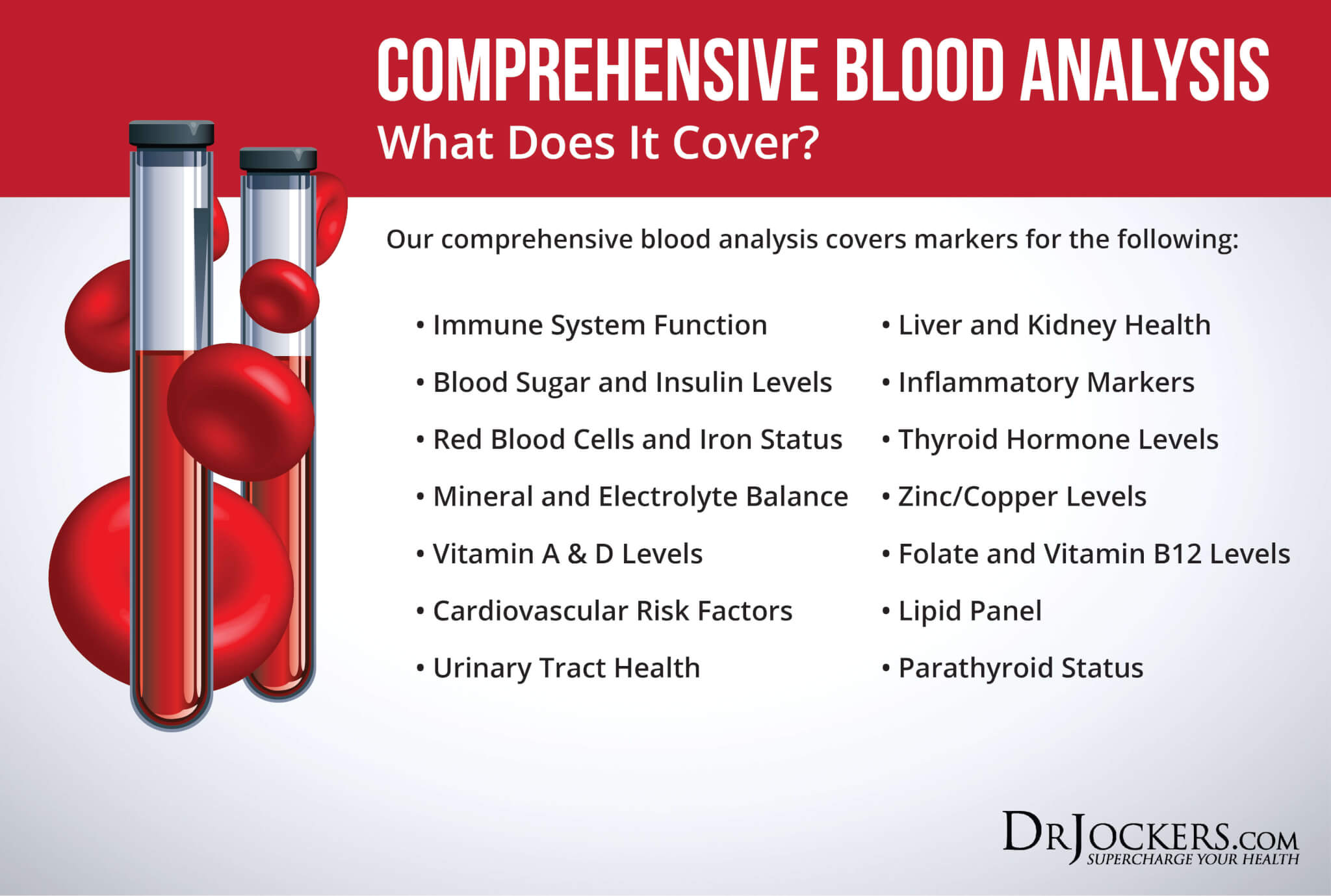







Thank you for this very interesting article.
Ok, you mention alternatives after breast removal, like fat injection and the other method but they are only feasable when you have your original breasts when breast implants were put to increase breast volume.
But what happens if you’ve had double mastectomy due to double breast cancer and you have no breast left? What is the alternative then for a healthier reconstruction? Solutions for this case have not been exposed here. What are the options then? I don’t see any.
Thank you in advance
I also have had double mastectomy and silicone reconstruction. I believe it is one of my problems with my health. What are my options? At 76 years old I am not concerned with reconstruction only a healthier me. Wonderful article. I am learning much. Thank You.
I was diagnosed with (CLL) chronic lymphocytic leukemia with no family history. I immediately thought it was caused by the breast implants and had them removed two months later. I then got tested for heavy metals known to be in the implants and found out I had antimony poisoning. They are now finding that BIA-ALCL (Breast Implant-Associated Anaplastic Large Cell Lymphoma) is not the only cancer being caused by breast implants. They are finding that many women are also being diagnosed with CLL caused by the implants. Who know how many other cancers are being caused by these breast implants.